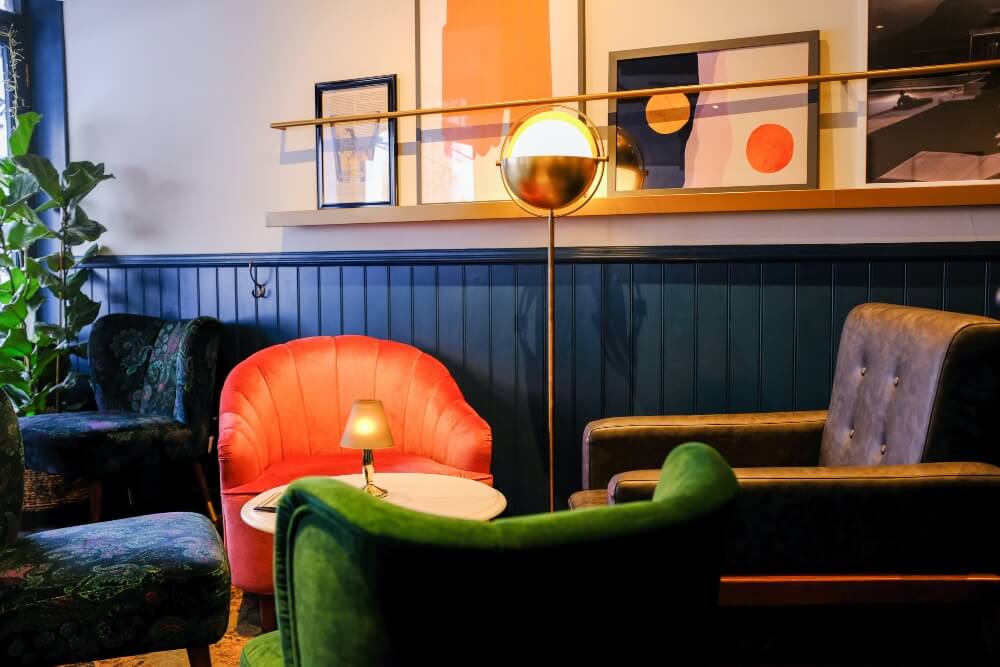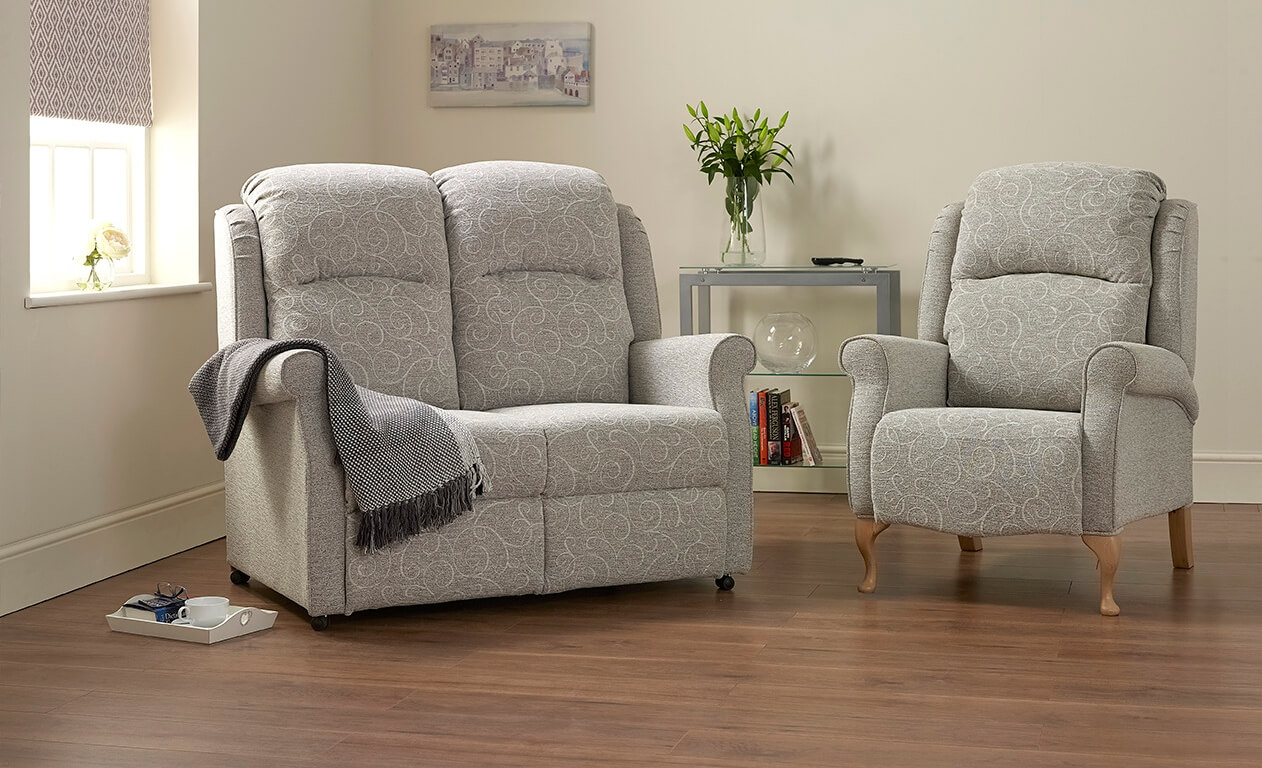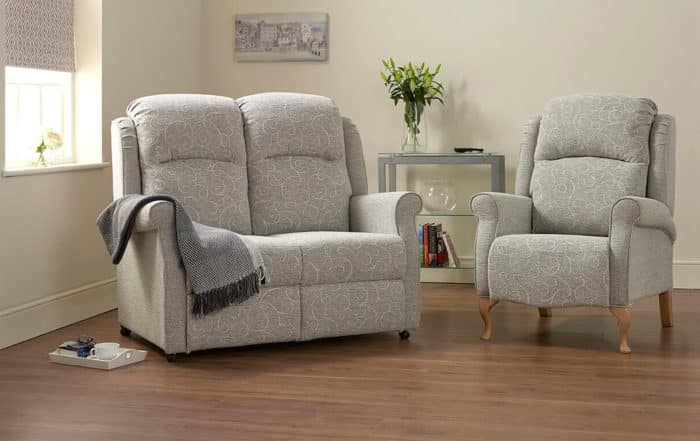9 Types of Recliner Chairs For Your Living Room
Social Links
There are many reasons for purchasing a new chair: perhaps you are moving house and feel the need for some new décor; your joints may be getting creaky and you crave a more supportive chair; a family member or close friend is ageing and has higher care needs; or maybe your favourite chair is simply worn out!
But how can we tell which type of chair is best for us? There are fabrics, mechanisms, and back styles to consider, not to mention if you do have health concerns, you’ll want a chair that will encourage and promote your mobility as much as possible. To help you decide, here’s our handy guide to the types of recliner chairs available, and the different ways they can and living space.
- Recliner Chair
- Rise & Recline Chair
- Power Recliner
- Manual Recliner
- Wall Hugger Recliner
- Fixed Chair
- Settee
- Sofa Bed
- Homecare Chair
1. Recliner Chair
Modern reclining chairs work by tilting back and raising the legs to support the body in a reclined position. As well as being a great way to nap or read your favourite book, this position has been shown to improve circulation and ease symptoms of indigestion – a positive solution if you’re partial to a little snooze after a meal.
While many are available, made-to-measure chairs are designed to be the most supportive and will minimise pressure on the joints and bones. This enhances comfort for any user, but is especially important for people with arthritis, or for anyone who will spend a lot of time in the chair, as it significantly reduces the risk of pressure sores.
2. Rise & Recline Chair
Rise and recliner chairs, such as our popular Cheshire and Suffolk models, do everything that recliner chairs do, with the added function of a forward tilt to assist users getting out of the chair. This is a convenient function for individuals who can move around independently, but lack the core strength to push themselves up.
For long term use, it’s always worth getting a riser recliner to future-proof against potential mobility issues. Though a simple addition, the rise function can have a great impact in prolonging independence, as you don’t have to wait for help to get up.
3. Power Recliner
The best reclining chairs use electricity and are operated by remote control. They may have a single motor, when the back and seat rests operate simultaneously, or a dual motor, which means they move independently. A dual motor allows for more precise positioning, which may be useful if you plan to do different things in the chair – for example, sit upright with your feet raised.
Power recliners are perfect for anyone who doesn’t have the flexibility or upper body strength to operate levers. Although they may require more initial investment, electric recliner chairs are relatively cheap to run, and may save you money in the end by ensuring you won’t have to upgrade if your strength declines. Just make sure you have space to put the chair close to a power source, where the cable won’t cause a trip hazard.
4. Manual Recliner
As the name suggests, manual recliners must be operated by hand. This is usually done by pulling on a lever, although some models may utilise body weight – for example, you recline the chair by leaning back, or return the footrest by pushing with your legs.
Manual recliners require strength to operate, so are not a good option for people with limited mobility or balance issues. They are generally cheaper to purchase, and can be placed anywhere in your living room or bedroom as there are no cables.
5. Wall Hugger Recliner
If you have limited space, for example if you live in a small apartment or want a chair for your bedroom, then a wall hugging chair is a clever solution. Wall huggers move forward as they recline, which means they don’t need as much clearance space behind them and can be placed right up against a wall or window.
Many of the Mobility Furniture Company’s recliner chair and sofa models come with a wall hugging motor function, including the Cheshire and Lincoln models in both single, two- or three-seater sofas. Wall hugger chairs can also tilt forward in space, so are still appropriate for people who need help getting in and out.
6. Fixed Chair
A fixed chair is designed to support the body in a sitting position but does not adjust or recline in any way. Reasons for buying a fixed chair may be to match an existing set, easier movability, budget constraints, or simply for the look.
Fixed chairs can still be made-to-measure for extra comfort and support, and customised with colours, fabrics and details such as metal legs or wooden arm scrolls. Additional features and accessories include high-support cushions, head rolls, removable covers and foot stools.
7. Settee
Settees, or sofas, have all the benefits of recliner chairs with the bonus of having extra space – whether you use it to put your feet up, snuggle up to a loved one or even as a home office. Mobility Furniture Company settees come as two- or three-seaters and can be made-to-measure, so you get the same health benefits as a well-tailored single seat.
Mobility Furniture Company sofas and settees operate just like rise and recline chairs, so you can put your feet up or recline back as you wish. Some, like our stylish Kent model, also have dual action motors, ie the seats can operate independently – fabulous if you want to sit up while your partner has a snooze.
8. Sofa Bed
Modern advances in sofa bed technology mean that these are now a viable option for longer term use, and not just for the occasional overnight guest. That makes them a wonderful solution for someone who finds themselves sleeping downstairs more often – for example when recovering from surgery.
only requires the touch of a button to completely assemble and pack away. When it’s not extended, you’ll still have a comfortable and supportive sofa to relax on – just make sure you have enough space in your room for the bed to extend.
9. Homecare Chair
Designed for safety and comfort, our homecare recliner chairs provide hospital-quality care in a home setting, giving extra support and safety for high-care patients and their carers. Many are designed to look like regular chairs, so don’t appear sterile or out of place in a bedroom or living room – like our modern-looking Chester chair.
Homecare chairs have extra features such as wheels, anti-bacterial and washable fabrics, high support cushions and removable foot plates. Some, including our Cheltenham model, also come with customisable backs and arm rests for maximum support and comfort.
The Bottom Line
There are many benefits to having a good reclining chair, from comfort and relaxation to the relief of aches, pains and all manner of medical conditions. Whether you want all these benefits now, or are anticipating future needs, choosing the right chair for you is not a process to be rushed.
Enjoy the process. Take some time to consider which will suit your needs, and remember that a made-to-measure chair will always provide the best support. And of course, if you’d like an expert opinion, you can contact the team at the Mobility Furniture Company for more information or a demonstration, so you can try out your new chair in situ. Once you’ve decided, you can put your feet up, relaxing in the knowledge you’ve picked the very best chair for your personal situation. Bliss.
*This website contains general medical information. The medical information is not advice and should not be treated as such. Read our full Medical Disclaimer here.



